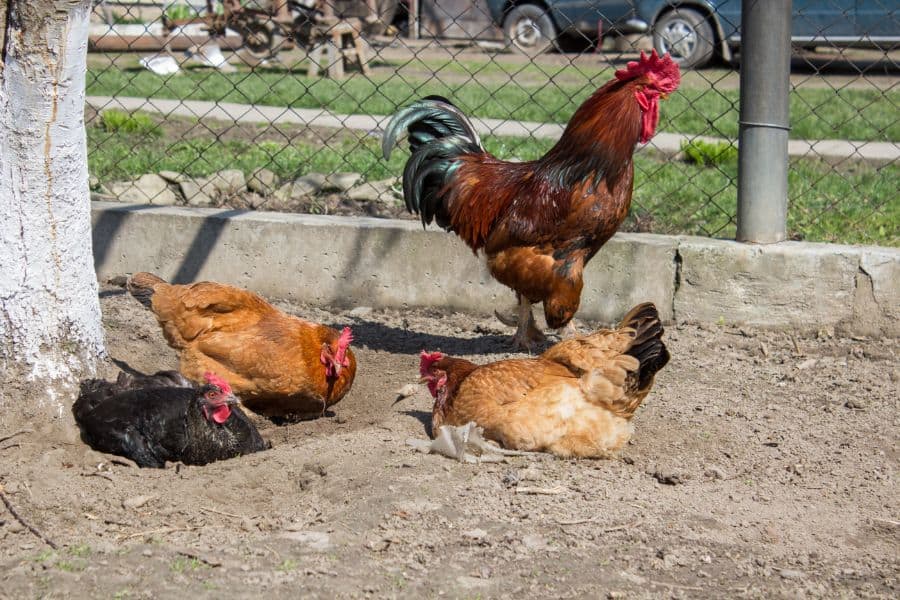Are your favorite feathered archeologists back at it again? Digging up miniature holes in your backyard and sabotaging your potted plants outdoors?
Well, your feathered buddies are passing a clear message, “Make us a dust spa.”
For the same reasons you visit a spa, chickens dust bathe to relax, enhance their health, and stay clean.
Filling up those holes and hoping the chickens will stop is a waste of time. Chickens must dust bathe, even those reared in “enriched cages.”
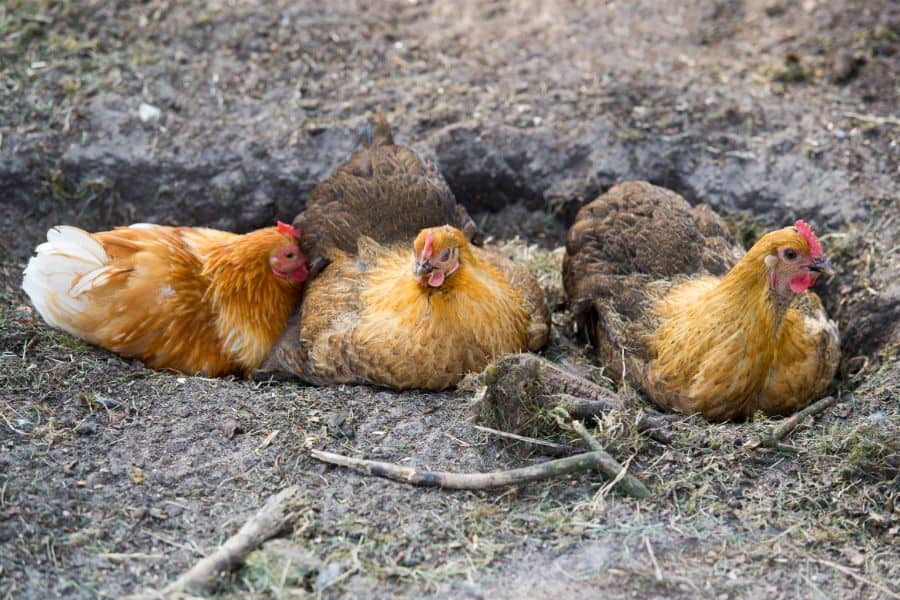
So, what’s the solution?
You must make them a dust bath, but more on that later!
At the moment, let’s focus our effort on understanding what a chicken dust bath is and why your birds need it.
What is a Chicken Dust Bath?
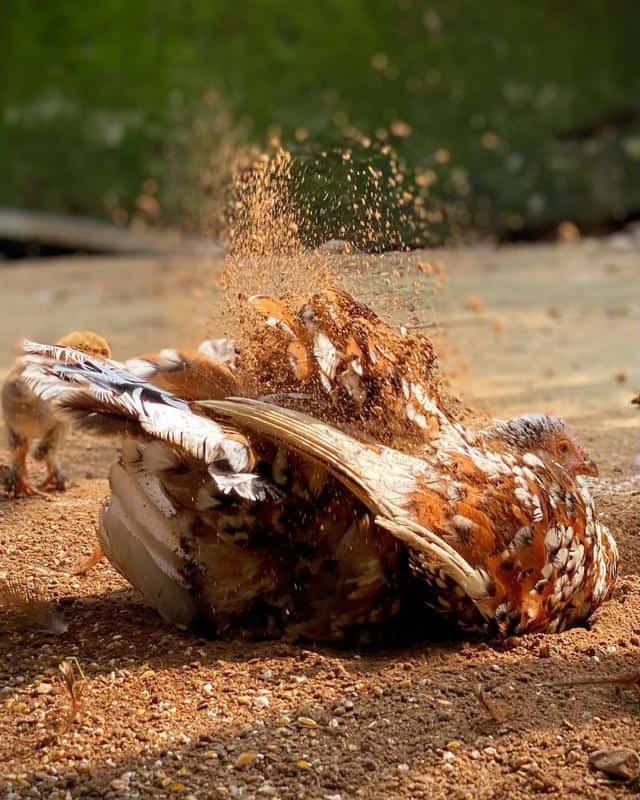
A dust or dirt bath is an area containing loose substrates like dirt or sand, where chickens can partake in one of their pastimes: dust bathing.
If you walk around your backyard during the day, you might observe your bird doing these:
- Searching for a spot with loose soil or dirt and digging it up using its beak and claws
- Once the hen or rooster is satisfied with the size of the hole, it delightfully fluffs its feathers out and settles them in the hole
- Next, the bird adjusts its body to lie on one side and wriggles to coat its feather with dirt
Oftentimes, the hen will turn side to side, repeating the process for about 20-30 minutes. Her fellow flock members might also join in the dust bathing session.
After enjoying their spa session, the birds finally stand up and shake their feathers vigorously to eliminate all the dirt and loose feathers. Some might even leave a dust cloud floating behind them.
Yes! Dust bathing might seem like a messy behavior, but it’s crucial for your birds. The session helps your chickens maintain their hygiene while giving them sufficient time to socialize.
Interestingly, this endearing activity also occur in other bird species and animals like Chinchillas, Chipmunks, and Zebras.
Why Do Chickens Take Dirt Baths?
A refreshing dust bath equals happy and healthy chickens and less strain on your pockets. In light of this statement, here are a few reasons chickens take dirt baths:
1. To Regulate the Amount of Oil on Their Feathers
Ever wondered why the feathers of chickens have a shiny look? Or why do they never get wet even when they get rained on?
It is because of the lipids coating the feathers. The oils keep the feathers clean, and water-resistant, plus improve their insulation and water-proofing properties.
Even better, these oils control ectoparasites like lice and mites.
Despite the advantage, a chicken’s oil gland may release excess oils onto the feathers, making the bird uncomfortable.
Fortunately, all the tossing and rolling during dust bathing allows the dust particles to settle on the chicken’s skin. As a result, they absorb excess oils and moisture, leaving your birds clean.
2. To Control External Parasites
It’s not uncommon for chickens to become infested with lice. These external parasites often feed on waxes, lipids on feathers, dead skin, blood, and anything else they can find on the bird.
If not controlled, these parasites can spread fast and cause the symptoms below:
- Dirty-looking vent feathers
- Reduced egg production
- Increased feather pulling
- Redness or scabs on the skin
Lice infestation could also lead to serious infections and diseases like anemia.
Your feathery friends might also fall victim to parasites like northern fowl mites, scaly-leg mites, and sticktight fleas.
But the good news is dust baths can help you control these pesky pests.
When chickens vigorously flap and roll in dust baths, they dislodge and remove external parasites underneath their feathers. The dirt particles can also clog the breathing pores of these pests, causing them to suffocate and die.
3. To Maintain Skin Health
Over time, dead cells can accumulate on the chicken’s skin, attracting parasites like lice, which feed on them. But regular dust bathing can help eliminate dead cells, reduce the chance of parasite infection, and promote healthy skin.
4. To Regulate Their Temperature
Dust baths also offer your girls an effective way to keep cool on hot summer days.
Unlike humans, chickens cannot regulate their body temperature by sweating. So, they prefer rolling, digging into the cooler layer of earth, and tossing in the dirt to keep their body temperature down.
Even during winter, your flock will still need to dust bath to stay clean, healthy, and comfortable.
5. To Build Communities
Most of the time, dust bathing is like a get-together beach party for chickens. It’s a spa session that allows the birds to catch up on the latest gossip.
It also fosters bonding among flock members and establishes a hierarchy order, reducing aggression.
6. To Have Fun and Enjoy the Day
In addition to socialization, dust-bathing makes chickens happier. As the birds toss and roll inside in the dirt, they relax and feel less stressed or anxious. This is particularly important for birds raised in confinement.
When Do Chickens Start Dust Bathing?
Did you know chicks start to dust bathe from a young age?
Dust bathing is an instinctive behavior in chickens. It’s in their genes! They don’t need to learn this from their mother.
So, don’t be surprised to see your 2 or 3-week-old baby chickens lying down in wood shavings or substrate to take a dust bath.
How to Make a Dust Bath for Chickens
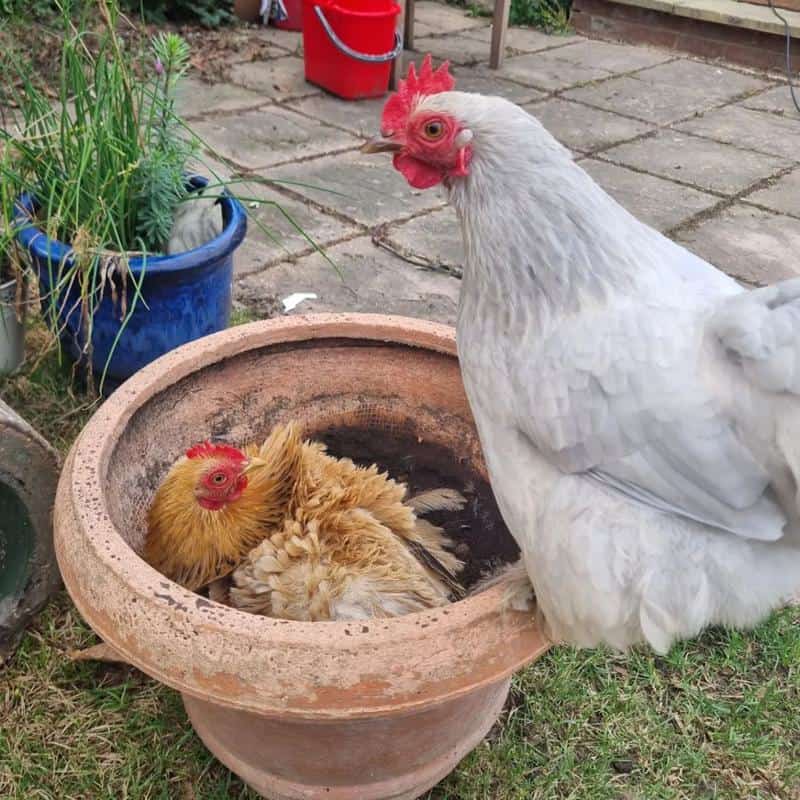
Making a dust bath for your girls is not rocket science. As a fact, you can go about this project in several ways. But the most effective approach involves the steps below:
1. Select A Suitable Location for A Dust Bath
Before choosing a dust bath spot for your chickens in the backyard, identify what your chickens love. Sometimes, you might think your chickens might like a particular area, only for them to dig their dust baths somewhere else.
If you wish to avoid such a situation, begin by analyzing areas in your yard frequented by your birds when dust bathing. Often, chickens love making their dust baths in spots exposed to sunlight but provide some shade when it gets hotter.
Your birds also enjoy locations that offer them easy escape routes when faced with predators, such as hawks.
But what if you want to build a dirt bath in the chicken coop?
In such cases, keep it far away from the waterers and feeders to avoid contaminating your flock’s water and food.
Moreover, place the dust bath away from the nesting boxes and perches. You do not want your chicken inhaling dust when sleeping or brooding.
The bottom line is to select a sheltered and safe location; where your chickens can be at their most vulnerable, but enjoy a good dusting session.
2. Choose A Suitable Dust Bathing Material
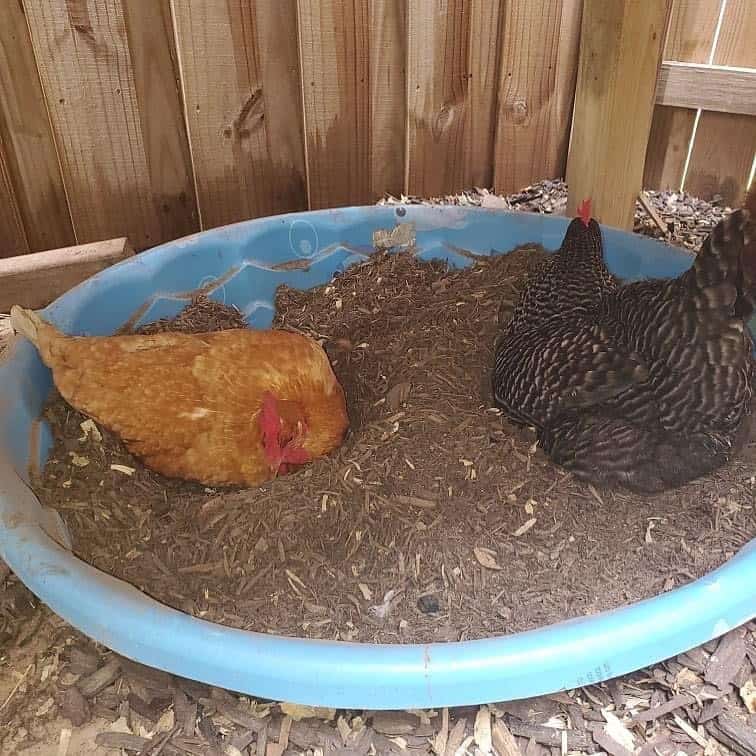
If you search online for the best dust bathing materials or substrate, you will get bombarded with so many options.
Some chicken enthusiasts recommend fireplace ash, while others say food-grade diatomaceous earth is all your need.
But if you ask experts, they will advise you to use plain old sand. However, you cannot use any type of sand to prepare the chicken dirt bath.
What Kind of Sand Is Ideal for A Chicken Dust Bath?
We recommend construction-grade sand. It is also known as contractor’s, multipurpose, or all-purpose sand.
Avoid using play sand because it gives off a lot of dust, which can cause respiratory issues in your birds. Chickens might also eat the sand–this can lead to impacted crops, especially in breeds like Silver Laced Wyandottes.
Alternatively, you can collect and use some clean, dry dirt from your chicken yard. But consider mixing them with the ingredients below for the best results:
- Sulfur dust: Research shows that sulfur works wonders against external parasites. Therefore, adding some sulfur to the dry dirt bath can help keep mites away. But remember, sulfur can be a toxic to humans in high doses.
- Peat moss: If you’re using a clay-soil-based dust bath, consider using peat moss. It keeps the bath soft, light, and non-compacted. Also, it absorbs water, keeping the dust bath from becoming waterlogged.
- Herbs: Borage, ginger, cinnamon, lavender, sage, and mint are great for the hen’s health. These herbs keep pests at bay. Not to mention, they have a nice scent. Chicken might also eat these herbs and enjoy their health benefits.
- Wood ash: Wood ash has the same effect as sulfur – it controls and kills ectoparasites. But this only applies to wood ash from untreated wood. Do not use ash from any other material.
- Lime: Your chickens will thank you if you add lime to their dust bath. Lime removes the odor in the coop, kills pests, and might improve your girl’s calcium levels.
Can You Use Diatomaceous Earth for Chicken Dust Baths?
There’s no agreed consensus when it comes to using Diatomaceous Earth (DE) for chicken dust baths. Some poultry farmers argue that it causes respiratory issues, while others say it’s perfectly safe.
But before we can determine if diatomaceous earth is ideal for dust baths, we need to understand what it is.
Diatomaceous earth is a fine powder made up of fossilized diatoms (microscopic aquatic algae) that collect in rivers and streams.
But what you need to know is that this material contains amorphous silicon (crystalline silica). If inhaled, the silica can cause silicate pneumoconiosis in chickens and silicosis in humans.
Luckily, food-grade diatomaceous earth contains less crystalline silica than industrial-grade DE.
And the best part? This white powder can work against harmful parasites like red mites when integrated into dust baths. It absorbs moisture and oils from the bug’s exoskeleton, causing it to dry out and die.
3. Get A Container to Hold the Dirt Bath Components
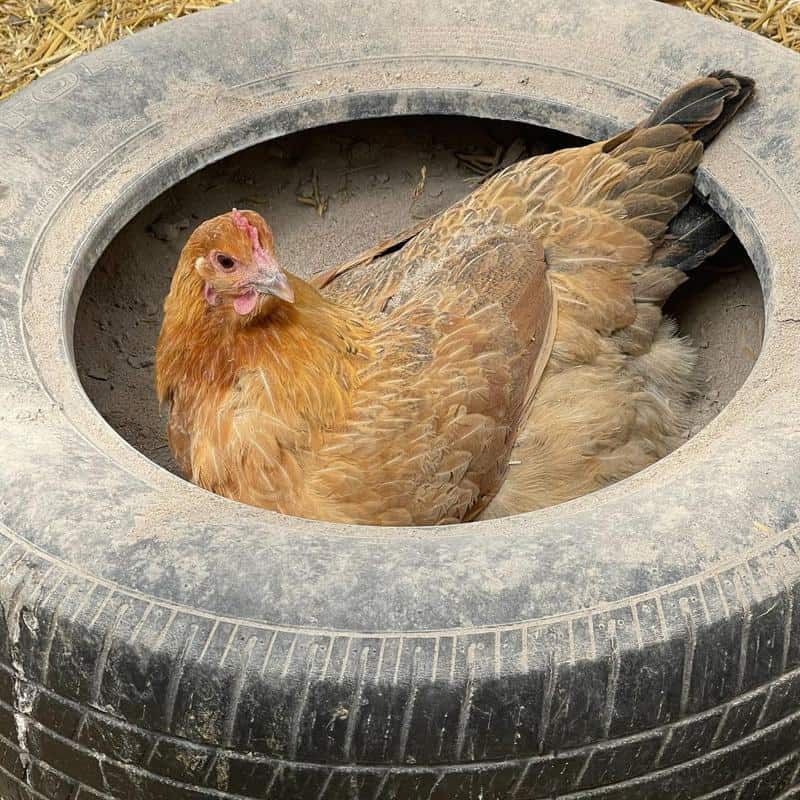
You have identified the most suitable dust bath location and materials, right?
It’s time to figure out how to contain the dust bath. That’s where a container comes into the picture.
A suitable container should be low enough so the hens and roosters can get in and out effortlessly. Also, ensure it’s the appropriate length to contain the dirt or sand when your birds toss and turn around.
Remember, chickens prefer visiting the dust spa as a community, so ensure the container is large enough to accommodate several flock members. This also reduces the chances of the chickens abandoning the dust bath for a better option.
Some suitable dust bath container options include:
- A large tire
- Galvanized tubs
- Large plant pots
- Shallow wooden boxes
- Large crates
- Shallow bins
- Surrounding the selected area with logs or large rocks
Do Chickens Like Water Baths?
No! Chickens dislike water baths, but not because they are scared of water.
In reality, if you train your birds to take water baths regularly from a young age, they’ll get used to it. And if you use warm water, it can help address issues like pasty butt in chicks.
Still, overall, a water bath is not necessary for chickens, and it might only stress them. So, you’re better off using dust baths.
Related: Can Chickens Swim?
Do Chicks Need a Dust Bath?
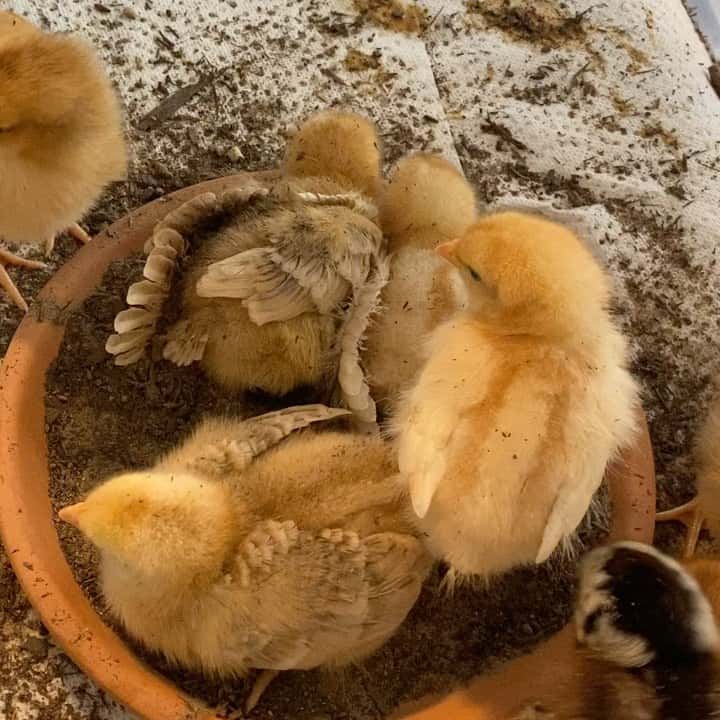
You got it right. Chicks also need a dust bath. However, avoid using diatomaceous earth in their bath because their lungs cannot handle the crystalline silica. Avoid using ash, lime, and sulfur dust too.
To give your chicks the best dust bathing experience, use materials like sand or peat moss mixed with clean dirt.
Place the material into a shallow container so that the chicken can climb in and out comfortably and safely. Next, position the dust bath container in the brooder and let the chicks get used to it.
At first, they might seem scared to approach it, but their curiosity will drive them to explore the bath. Eventually, the curious furry balls will learn its purpose and may even get carried away with bathing.
Also Read:
Take Away
As we wrap up without our guide, here are a few things we have learned:
- Chickens start dirt bathing from a young age – around 2 to 3 weeks of age
- All chickens take dust baths to keep clean and enhance their health
- You should work with your chickens when determining the best location for their dirt bath
- Chickens prefer peat and dirt more than other dust bath materials
- Keep off diatomaceous earth for dust baths unless it is necessary to use it
If it’s your first-time seeing chicken dust bathe, you might think it’s having a seizure. But as you remember, we said this behavior is instinctive. It’s written in their DNA. And also, it’s crucial for their survival.
When chickens don’t dust bathe, they might get infested with parasites that carry diseases like red mites and lice. They might also develop feather pecking problems and suffer from heat stress.
Making dirt baths for your flock will help you keep them healthy, clean, and happy, whether they are free-range or housed on wire cage floors.
But before we go, understand that no matter how many dust baths you provide for your birds, some might ignore them. So, don’t be afraid to experiment with various options until you find the one that works for them.
